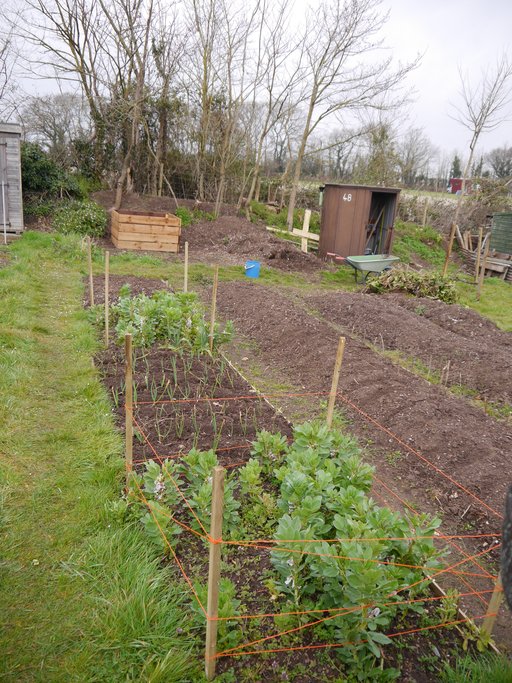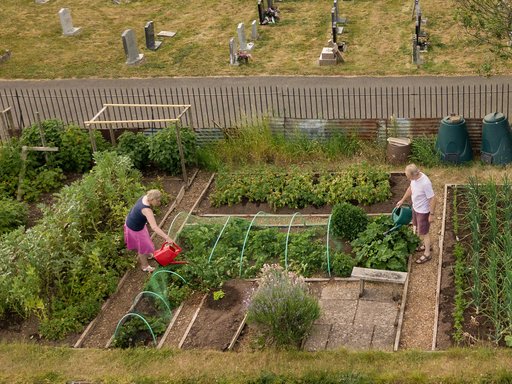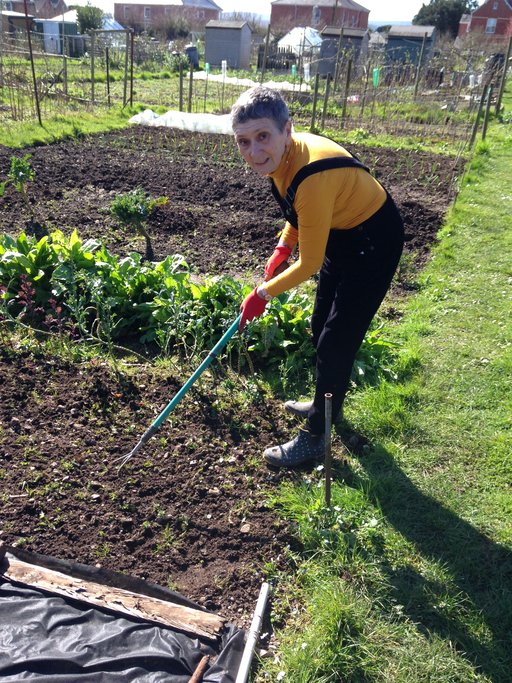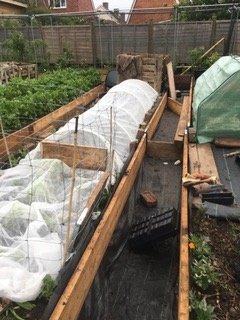Allotment Portraits

Below are the stories of a few allotment tenants and their relationship with their allotments. If you'd like to tell your own allotment story, please email it to the website manager, don't forget to include at least one picture.

Phil
I am lucky to have a half allotment at the Sunhill site in Topsham, looking down over the Clyst valley. I have six beds along the allotment, across the slope to avoid the soil washing away. One bed is for perennials, and I use a simple rotation for annual crops on the rest.
I take a no-dig approach, disturbing the soil as little as possible and not compacting the soil by treading on it. This allows the soil structure and organisms to develop, and encourages retention of carbon in the soil. The soil has noticeably improved since I have had the allotment, and it is now quite quick and easy to clear weeds and prepare beds for the next crop.
As I aim to avoid harm to others, I do not use either chemicals or products taken from animals (including manure) - a well-established approach known as veganic or vegan organic growing.
When I took on the allotment I made a pair of compost bins, consisting of stacked-up square wooden frames. As compost develops and sinks in one bin, I can transfer the top frames to other bin as that one is filled. When I can get it seaweed is a great compost activator, speeding the breakdown of plant materials. Once the compost is ready, I can remove frames so that it is easy to dig it out. I use the compost as a mulch on the bed surfaces, for worms to take into the soil.
I try to keep the soil covered as much as possible, to protect its structure and stop nutrients being washed away. Apart from my own compost and the council compost sold by TAGS, I use a variety of green manures between crops and on empty beds over winter. I find phacelia usually grows well, and has lovely mauve flowers that attract lots of insects. Tares gives ground cover over winter if sown in early autumn, and if I have spare broad bean seeds I sow extra - both will fix nitrogen. Crimson clover has lovely flowers that feed insects, and again it fixes nitrogen - I sometimes grow it between my brassicas.
Within reason I don't mind sharing some of my crops with the local wildlife - like me they are just trying to survive and to feed themselves and their families. If they are wanting the entire crop, rather than killing some of them I try to use deterrent methods. To keep pigeons and cabbage white butterflies off my brassicas I build temporary cages from wooden frames covered with netting. These are quite easy to open for picking, and I've had no trouble from birds or caterpillars since using them. To keep slugs from vulnerable seedlings, I put round them a small collar cut from plastic waste pipe with a band of stick-on copper tape. These usually keep slugs and snails away until the plants get going and can look after themselves. My globe artichoke heads were being covered with green aphids, so I now put a band of tree grease round their stems. This stops ants coming up the stems to "farm" and protect the aphids, and I now get very few of them on the heads. I tie orange cord to stakes around my broad beans - apart from supporting them, this deters pigeons who don't like going behind the cord where they don't have a clear flight exit.
Along with the regular vegetables, I like to try a few less common ones from time to time. One real success is sea beet, which is grown as a perennial and produces spinach-like leaves. We enjoy these better in meals than the chards; I don't need to sow new seeds each year; and the plants keep going through the winter to provide welcome fresh crops in the spring. I really like my buffalo currant bush, which has lovely yellow flowers with a cinnamon-like scent, and beautiful red leaves in the autumn. The fruit are a bit like thick-skinned blackcurrants and not very exciting, but I like to keep the bush as it is so attractive. Recently I managed to get a small perennial kale plant, the Taunton Deane variety. These are supposed to grow very large (up to 2 metres tall), so I have hopes for that doing well.
For the past couple of years I have been growing some oca, a plant from the Andes which has small tubers in a variety of colours. The plants are interesting and attractive - the tubers have a lemony taste, and can be eaten raw or cooked. We're not very keen on them though, so I might find something else to take their place!
I love spending time on my allotment, and taking home fresh vegetables and fruit. I am very pleased that in this small area I can grow in a way which retains carbon and respects the lives of others - part of a worldwide network of farmers, growers and gardeners growing healthy food without relying on the agrochemical and animal agriculture industries which cause such devastating harm to health and environment.

Trevor and Deborah
Our allotment is in the north-east corner of the Cemetery site. We’ve been the tenants for about 15 years and it has become an important part of our lives, giving us a great deal of pleasure – and the produce has been pretty good too!
We were both still working when we moved into Topsham, choosing a house with a small garden and car parking, and decided to see if we could rent an allotment plot, ready for retirement. We were keen to grow our own fresh and organic ‘slow food’, develop a more healthy lifestyle, have some additional exercise, but also to have somewhere with space to enjoy and the opportunity to meet with other people away from home and work. It has been a success for us on all counts! We enjoy maintaining the plot in many ways: planning, creating the infrastructure (paths, raised beds, fruit cages, compost bins, somewhere to sit and, of course, the delights of ‘having a shed’), digging, composting, sowing and planting, weeding and nurturing and, if we’re lucky, harvesting and consuming. And doing all this surrounded by all sorts of birds and wildlife in a friendly and welcoming environment. There are always neighbouring allotment holders with whom to trade surplus plants or crops, swap advice and discuss the weather prospects.
We’re not all that adventurous with our planting, but each year we try to have a mixture of vegetables ( potatoes, onions, parsnips, carrots, courgettes, leeks, broad and dwarf beans), salads, fruits (strawberries, raspberries, red and black currants) and a few flowers (the dahlias are nearly always good). We regularly bring our vegetable trimmings up to the allotment and add them to our compost bins and try to get some farm manure annually to keep the soil well-fed and productive. Then there is a lot of weeding and watering to be done, but still find the time for a coffee on the bench and someone to chat to.
Problems? We have had a few failures, some caused by hungry snails and slugs or greedy pigeons, but mainly due to inadequate watering (worsened by having adjacent thirsty trees). Then there’s the problem of getting back home late as there is nearly always someone to chat with on the way out through the gates……..

Helen and Bob
We moved to Devon in 2018 after living in France for 12 years and were lucky enough to secure an allotment on the Butts Park site.
We have always enjoyed growing fruit and vegetables and have worked on several sites over the years. Returning to the UK meant we had to relearn what varieties to plant and when . Luckily there is a always someone around to offer helpful advice . Having an allotment is a wonderful way to relax and get fit and you get to enjoy the benefits of the harvest.
There is nothing like the taste of freshly picked vegetables. Most of our diet is vegetarian which
we feel enhances our healthy lifestyle. Recipes are often swapped with neighbours on the plot.
In addition to vegetables we inherited raspberry canes and have planted blackcurrants and
thornless blackberries . It is always a great pleasure is to give surplus to friends.
When the hard work is finished our plot gives us a great place to sit and enjoy a cup of coffee. Although the birds can be a nuisance it is lively to sit quietly and hear their songs.
The additional benefits of having an allotment are social. We have made great friends here and enjoyed the activities that The Allotment and Garden Society offer each year. One of the highlights of the year is the annual Show. We haven’t managed any prize winners yet but it is always great fun to enter and admire the exhibits.
During this difficult time of the pandemic of coronavirus our allotment has given us a daily sense of purpose . It really has kept us well physically and mentally.

Donald McLintock - No Dig raised beds
Donald McLintock has written a comprehensive article sharing his experience creating "No dig" raised beds you can read it by clicking on the picture
